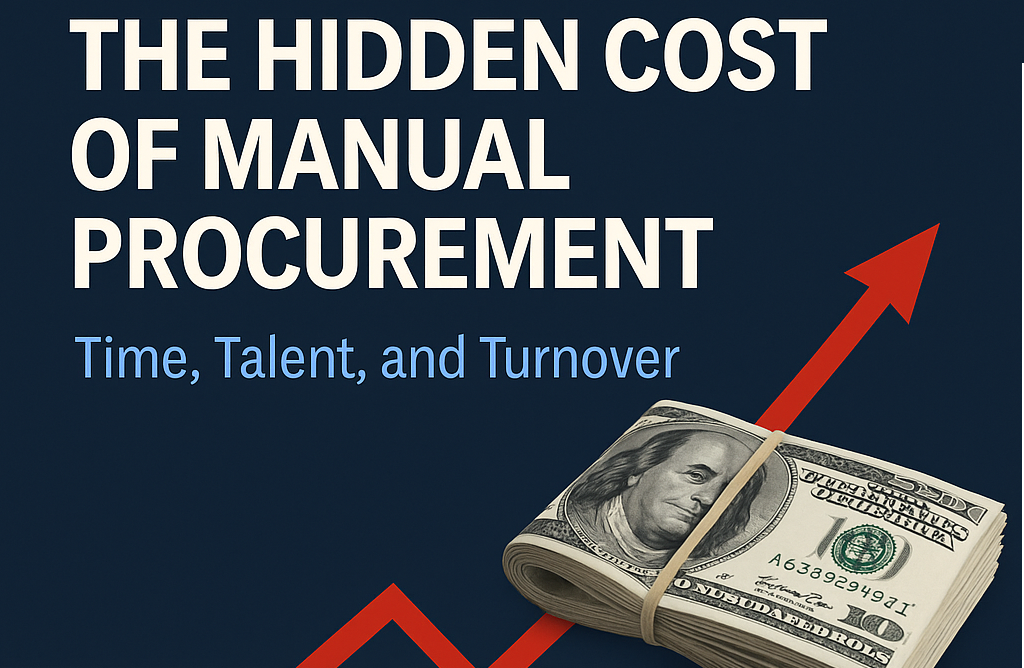In an era where automation drives everything from cars to coffee machines, it’s startling how many businesses still rely on manual procurement processes. Tools like spreadsheets, email chains, and shared drives may feel familiar, but they carry enormous hidden costs—slowing productivity, draining morale, and pushing talented procurement professionals toward the exit. This article takes a closer look at the ripple effects of outdated procurement workflows—and how much they truly cost your business.
The Silent Saboteurs: Time, Errors, and Burnout
Manual procurement is a productivity killer. It slows down cycle times, increases error rates, and places a heavy burden on procurement teams. According to The Hackett Group, top-performing procurement teams that automate their processes can process purchase orders 76% faster and at 55% lower cost than those using manual methods.
A 2022 report by Levvel Research revealed that 43% of companies still use manual processes for invoice approvals, leading to an average processing cost of $15 per invoice, compared to $2.36 with automation. Multiplied across thousands of invoices, this results in millions of dollars in avoidable spend.
Manual processes also introduce significant errors. A study by PayStream Advisors found that 3.6% of invoices processed manually contain errors, often resulting in duplicate payments, late fees, or lost early payment discounts. In one case, a global pharmaceutical company uncovered over $2 million in overpayments stemming from duplicated invoices and missed contract terms due to lack of automation.
Turnover Triggered by Tools
It’s not just operational efficiency at stake—manual procurement is a talent repellent.
In 2023, Procurement Leaders surveyed over 600 procurement professionals. The results? 68% cited “outdated tools” as a major source of job dissatisfaction. More than 40% had actively considered leaving their current role due to repetitive, low-value tasks like invoice matching and vendor communication through fragmented systems.
One notable example: A major CPG company in North America reported a 34% attrition rate in its procurement function over an 18-month period. Exit interviews cited frustration with redundant data entry and lack of visibility into supplier performance. After implementing an integrated procurement automation platform, the company reduced attrition by over 60% and decreased cycle times by 40%.
Furthermore, modern workers expect modern tools. Gen Z and younger Millennials entering the workforce are digital natives—used to intuitive, integrated apps. Forcing them to rely on Excel macros and email approvals is a quick way to lose rising talent.
Strategic Blind Spots and Bottlenecks
Manual procurement doesn’t just waste time—it actively undermines strategic decision-making.
Without centralized dashboards or real-time data integration, procurement leaders are often flying blind. According to a 2023 study by Ardent Partners, only 27% of companies with manual procurement processes reported having full visibility into their spending. This contrasts sharply with 78% of digitally mature organizations that leverage real-time dashboards and analytics.
Consider a mid-sized aerospace supplier that lost out on a multi-million-dollar government contract because they couldn’t quickly pull supplier compliance data during the bidding process. Within six months of integrating automated compliance tracking and supplier scoring, the company not only landed its next contract—but saved over $750,000 by consolidating redundant vendors.
Another Fortune 100 healthcare organization using spreadsheets across its regional procurement offices faced months-long delays reconciling global supplier performance metrics. After adopting an integrated solution, they reduced that reconciliation window from 8 weeks to 2 days and cut contract renegotiation lead time in half.
Innovation Blocked at the Source
When procurement teams are stuck performing repetitive administrative work, they don’t have time to innovate. That might mean missing opportunities to negotiate better supplier terms, explore nearshoring options, or invest in sustainable sourcing initiatives.
A 2022 McKinsey report found that procurement teams using automated tools spend 23% more time on strategic initiatives compared to those bogged down by manual processes.
For example, Siemens transitioned to a digital procurement system that integrated predictive analytics. This allowed their teams to proactively spot price fluctuations and shift sourcing strategies, resulting in €300 million in annual savings.
Similarly, Unilever has embedded automation across its global sourcing hubs, enabling faster decision-making and reduced procurement cycle times by 40%, freeing up teams to focus on supplier innovation and ESG performance.
Conclusion: Manual Procurement Is Too Expensive to Keep
Manual procurement isn’t just inefficient—it’s expensive, stressful, and unsustainable. The cost isn’t just in dollars and cents, but in employee satisfaction, missed opportunities, and strategic paralysis. As supply chains grow more complex and agile sourcing becomes a competitive advantage, organizations that cling to spreadsheets risk falling dangerously behind.
Investing in modern procurement systems is more than an operational upgrade—it’s a competitive necessity. The time to act is now.
Author: Ed Danielov
Publication Date: August 7, 2025
© Copyright 2025 Perfect Planner LLC. All rights reserved.
References
- The Hackett Group. (2023). Digital World Class Procurement Performance Study. https://www.thehackettgroup.com
- Ardent Partners. (2023). Procurement Metrics That Matter. https://ardentpartners.com
- Gartner. (2022). Digital Procurement Transformation Survey. https://www.gartner.com
- Deloitte. (2022). Procurement Workforce Outlook. https://www2.deloitte.com
- McKinsey & Company. (2022). How to Free Procurement for Strategic Impact. https://www.mckinsey.com
- PayStream Advisors. (2021). Payables Insight Report. https://www.netsuite.com
- Levvel Research. (2022). Procurement Automation Trends. https://www.levvel.io
- Procurement Leaders. (2023). State of Procurement Talent Report. https://www.procurementleaders.com
- Siemens Global. (2023). Digital Transformation in Procurement. https://www.siemens.com
- Unilever. (2022). Driving Sustainable Sourcing Through Digital Tools. https://www.unilever.com






